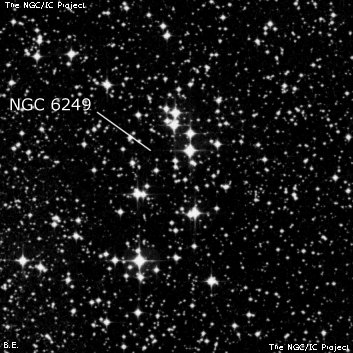
John Herschel discovered NGC 6249 = h3655 = D 455? on 1 Jun 1834 and recorded "cluster VIII class, coarse, p rich, stars 9...12m." On a second sweep (27 Jul 1834) he logged it as "VII class, p rich, loose irreg fig; large and small stars, 9...15m; 10' long, 7' broad."
James Dunlop may have been the first to find this cluster on 31 Jul 1826 with his 9-inch homemade reflector from Parramatta NSW, and described D 455 as "an extremely faint ill-defined nebula, easily resolvable into stars; this is in the milky way." His position, though is just over 40' WSW of the cluster, so the identification is very uncertain.
300/350mm - 14" (4/5/16 - Coonabarabran, 145x and 178x): bright, moderately large cluster with ~50 stars mag 10 to 14 scattered over a 7' region. Many of the stars are arranged roughly in a "C" or horseshoe shape open to the east. The most prominent part includes 4 mag 10-11 stars in a small trapezoidal shape (parallel sides N-S). Three additional mag 10-11 stars are spread out south of this trapezoid; the northern one is a 10" pair and several additional pairs caught my eye. NGC 6259, a showpiece cluster, lies 33' NE.
Notes by Steve Gottlieb